This post may contain affiliate links. Please read our disclosure policy.
Craving some authentic Louisiana Gumbo but don’t want to make a gigantic pot? Welcome to the perfect solution—a single serving Seafood Gumbo Recipe that delivers on flavor without overwhelming your kitchen. This simple, yet profoundly tasty gumbo is filled with shrimp, fish, and the crucial trinity of vegetables: onions, celery, and bell peppers. Ideal for those cooking for one or a cozy dinner for two, this downsized recipe keeps the shopping list short without sacrificing taste.
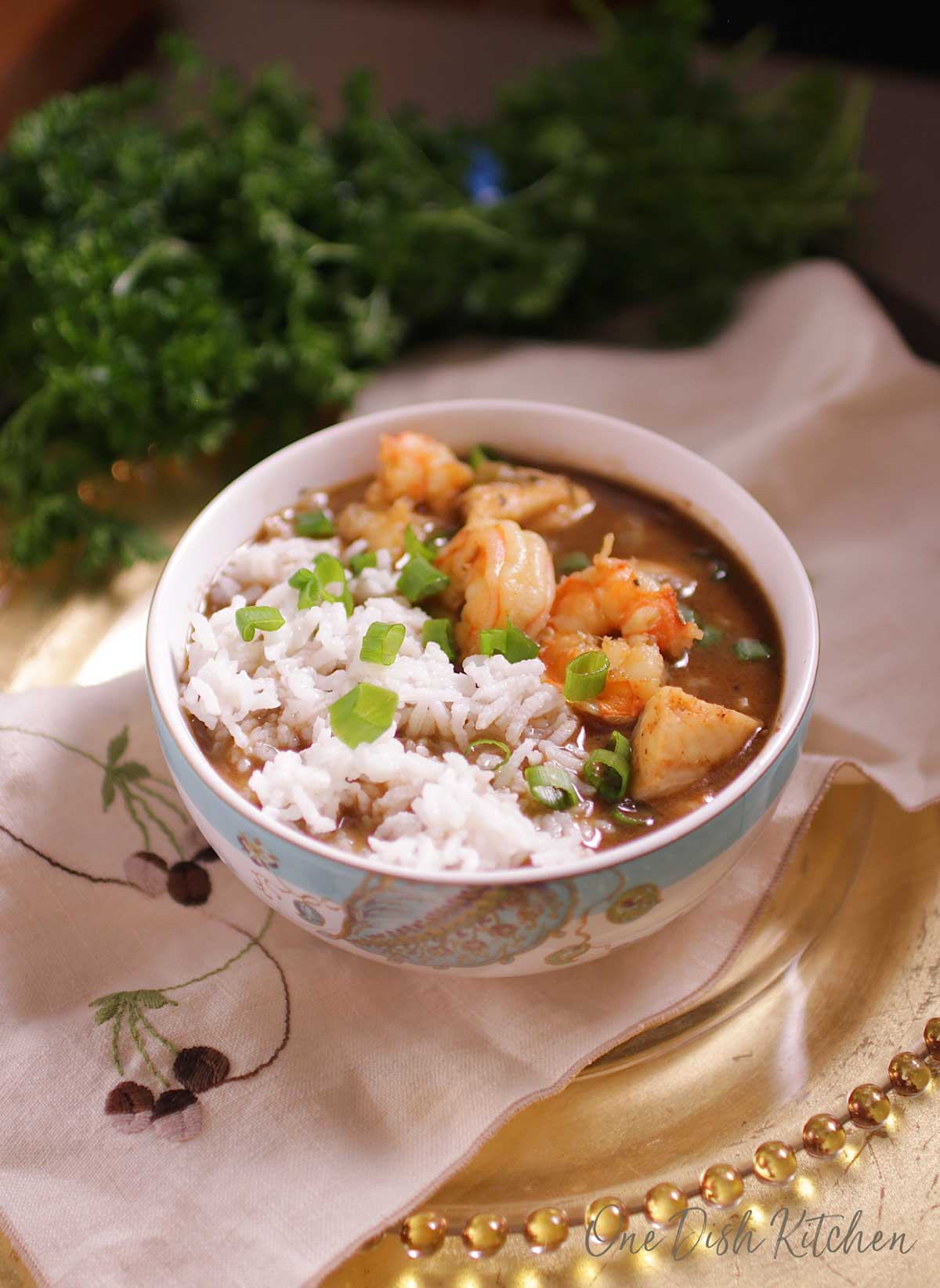
Craving more tantalizing Louisiana flavors in single serving portions? Delve into our delightful Shrimp Creole, the zesty Jambalaya, the succulent Crawfish Étouffée, and the festive King Cake for a taste of the bayou that’s perfect for one.
Table of Contents
- A Gumbo For One: A Family Favorite Downsized
- Why You’ll Love This Seafood Gumbo Recipe
- What Is Gumbo?
- Ingredients
- Recipe Variations
- How To Shop For Shrimp: A Guide
- How To Peel And Devein Shrimp: A Simple Guide
- Mastering The Perfect Roux For Your Gumbo
- How To Make Seafood Gumbo For One
- Expert Tips
- Serving Suggestions
- Frequently Asked Questions
- Ways To Use Leftover Ingredients
- Seafood Gumbo For One Recipe
A Gumbo For One: A Family Favorite Downsized
I couldn’t be happier to share this single serving seafood gumbo recipe with you. Hailing from New Orleans, the birthplace of gumbo, crafting a downsized version of this beloved dish has been a goal of mine for quite some time.
Back when my kids were still living at home, gumbo was the one meal that united us all. It’s a dish filled with love and flavor, something my family always eagerly anticipated. Now, I’ve successfully scaled down the ingredients to serve just one or two, making it perfect for those cooking for fewer people but still craving that authentic New Orleans taste.
Why You’ll Love This Seafood Gumbo Recipe
- Simplicity: Minimal ingredients and straightforward steps make this recipe accessible.
- Authenticity: Though scaled-down, it retains the traditional flavors and textures of gumbo.
- Versatility: Suitable for various dietary preferences with multiple substitution options.
- Quick Prep Time: Get that simmering gumbo pot without spending hours in the kitchen.
- Portion Control: Tailor-made to serve one or two, eliminating food waste and unnecessary leftovers.
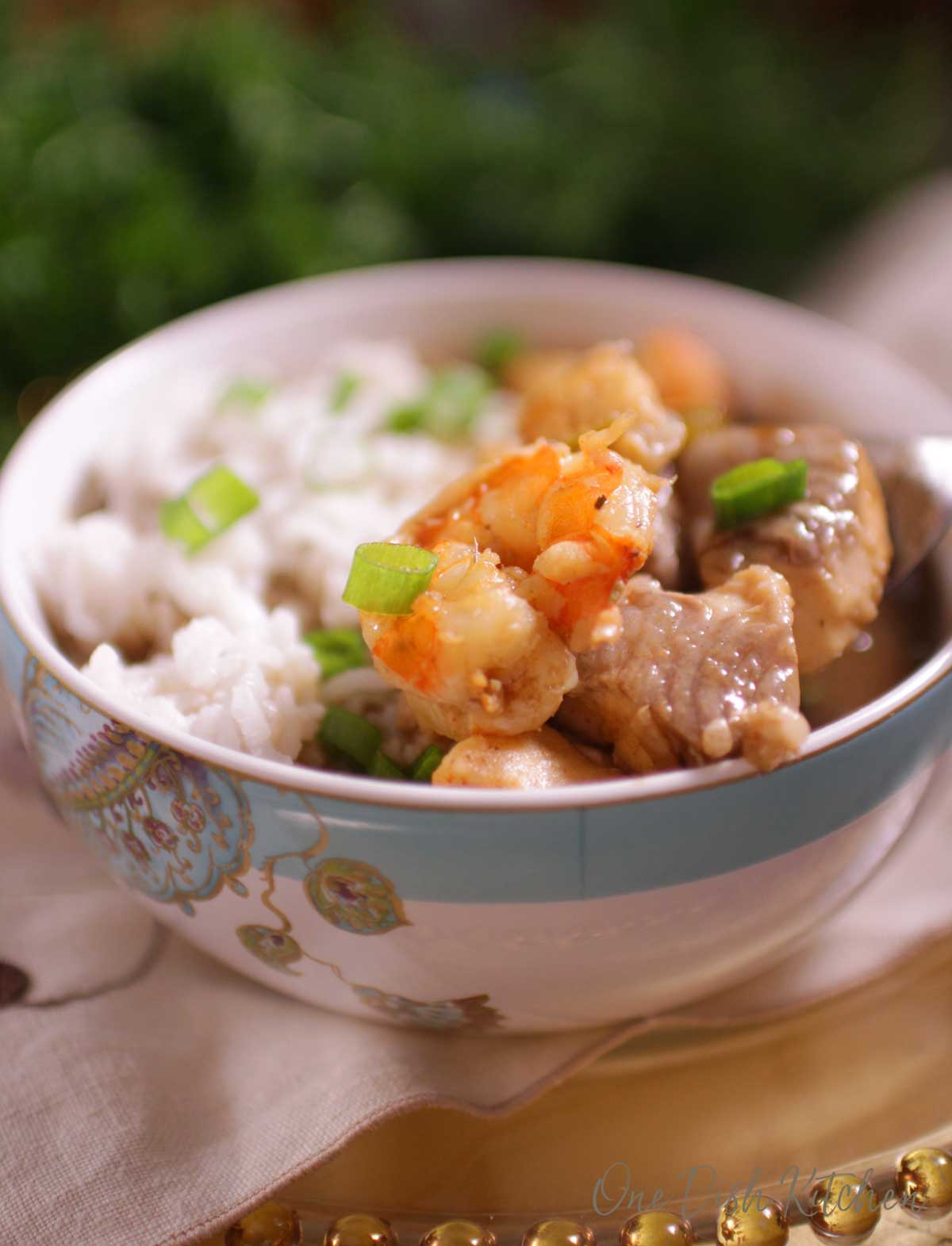
What Is Gumbo?
Gumbo is a savory stew that originated in Louisiana, combining influences from French, African, and Native American cuisines. It often features a strong-flavored stock or broth, meats or shellfish, and the iconic vegetable trio known as the “holy trinity”—onions, celery, and bell peppers.
Ingredients
Beer is shown in the ingredient photo. When I make a big batch of gumbo, I like to add beer for extra depth of flavor. For this single serving recipe, the amount of beer I would have used was minimal, so I chose to leave it out since it didn’t make a noticeable difference in the flavor. I did not update the photo because enjoying your gumbo with a cold beer on the side is always a great idea! Cheers!
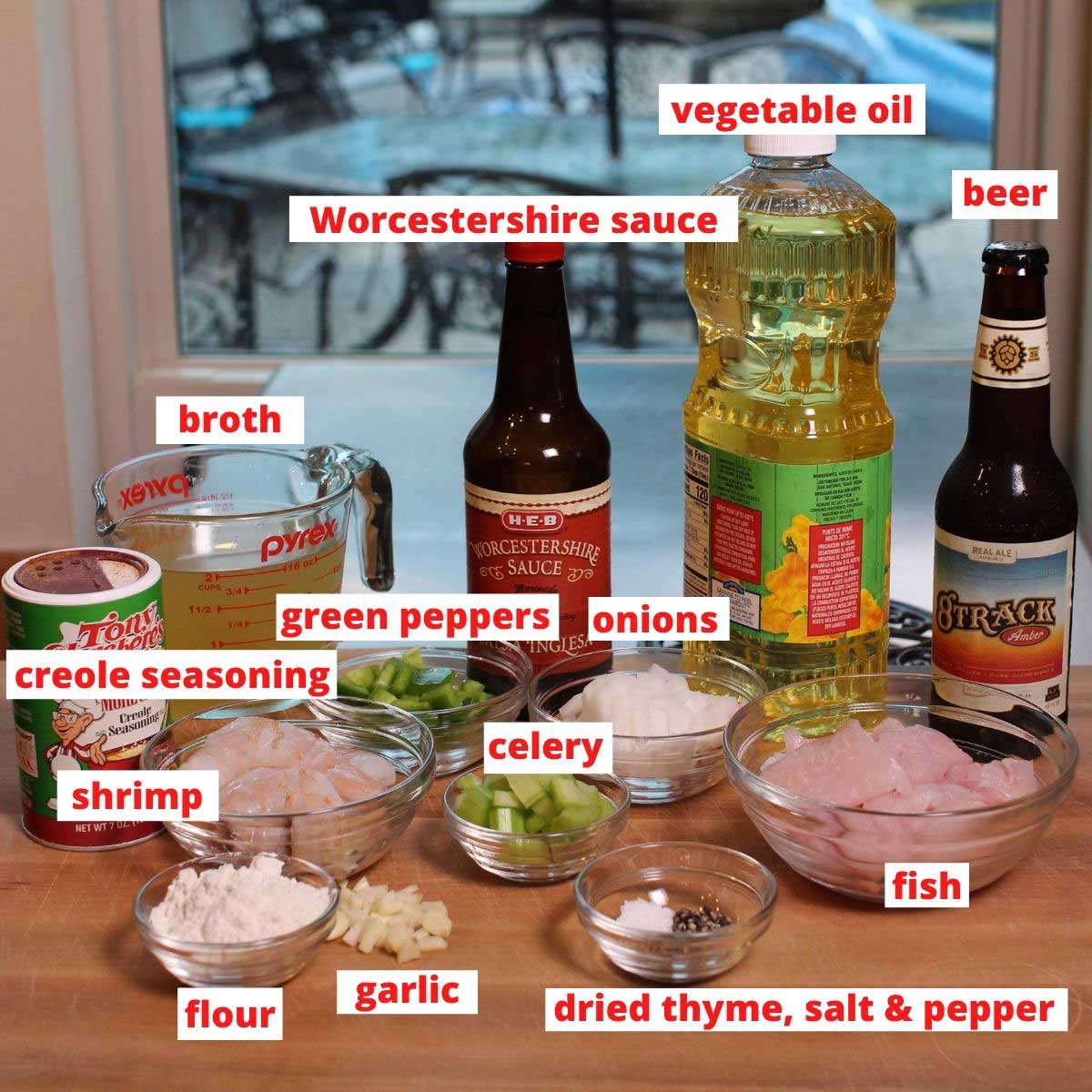
Simplifying classic recipes is what I love to do, especially when it comes to iconic dishes like seafood gumbo. Here’s a streamlined, single serving version that doesn’t compromise on flavor while being ideal for those cooking just for themselves or a small group.
- Vegetable or canola oil: For making the roux, choose a neutral oil like vegetable or canola. Though some folks enjoy using butter, I steer clear because butter burns more easily. Oil offers a higher smoke point, allowing for a darker and richer roux.
- All-purpose flour: The key to thickening your gumbo is a well-made roux, and for that, all-purpose flour is your go-to ingredient. For a gluten-free alternative, use gluten-free measure for measure flour.
- Chopped onions, green bell peppers, and chopped celery: These make up the ‘trinity of vegetables,’ a cornerstone in many Louisiana recipes. As for tomatoes, they’re not traditionally part of Cajun gumbo, but feel free to add if you like.
- Minced garlic: Adds that essential aromatic touch. We use this combination of vegetables in many of our single serving and small batch recipes like Crawfish Pasta.
- Chicken broth: Most people already have this staple in their pantry, making it a convenient choice for fish gumbo. For a seafood-forward flavor, go for shrimp stock.
- Dried thyme, Worcestershire sauce, salt, and pepper: These bring additional layers of flavor to your gumbo. For a gluten-free gumbo, make sure your Worcestershire sauce is gluten-free.
- Shrimp: Gulf shrimp is my top recommendation. Remember to peel and devein before adding them to your gumbo. Frozen shrimp can be used if fresh is unavailable; just be sure to thaw them first. If you have any shrimp leftover from this gumbo recipe, consider using them in Shrimp and Grits, Pad Thai, and Shrimp Tacos.
- White fish: I typically go for catfish, cod, sea bass, or snapper in my seafood gumbo. Tilapia is a good alternative if you’re looking for a fish that is often less expensive. If you’ve got an extra piece of fish, consider using it to make Baked Stuffed Fish.
- Creole seasoning: Use either homemade Creole seasoning or use a brand like Tony Chachere’s for that authentic Creole flavor.
This section provides a quick rundown of the ingredients used in this Gumbo recipe. For complete measurements and step-by-step instructions, please scroll to the recipe card located at the bottom of this post.
Recipe Variations
Want to shake things up a bit? Here are some ways to put your personal spin on this classic gumbo recipe:
- Seafood and Sausage Gumbo: Add some andouille sausage for extra meatiness.
- Vegetarian Gumbo: Skip the seafood and add okra and mushrooms.
- Gluten-Free Gumbo: Use gluten-free flour for the roux.
- Creole Gumbo: Add a quarter-teaspoon of gumbo filé powder for an earthy kick.
- Chicken Gumbo: Use chicken instead of shrimp and add sausage.
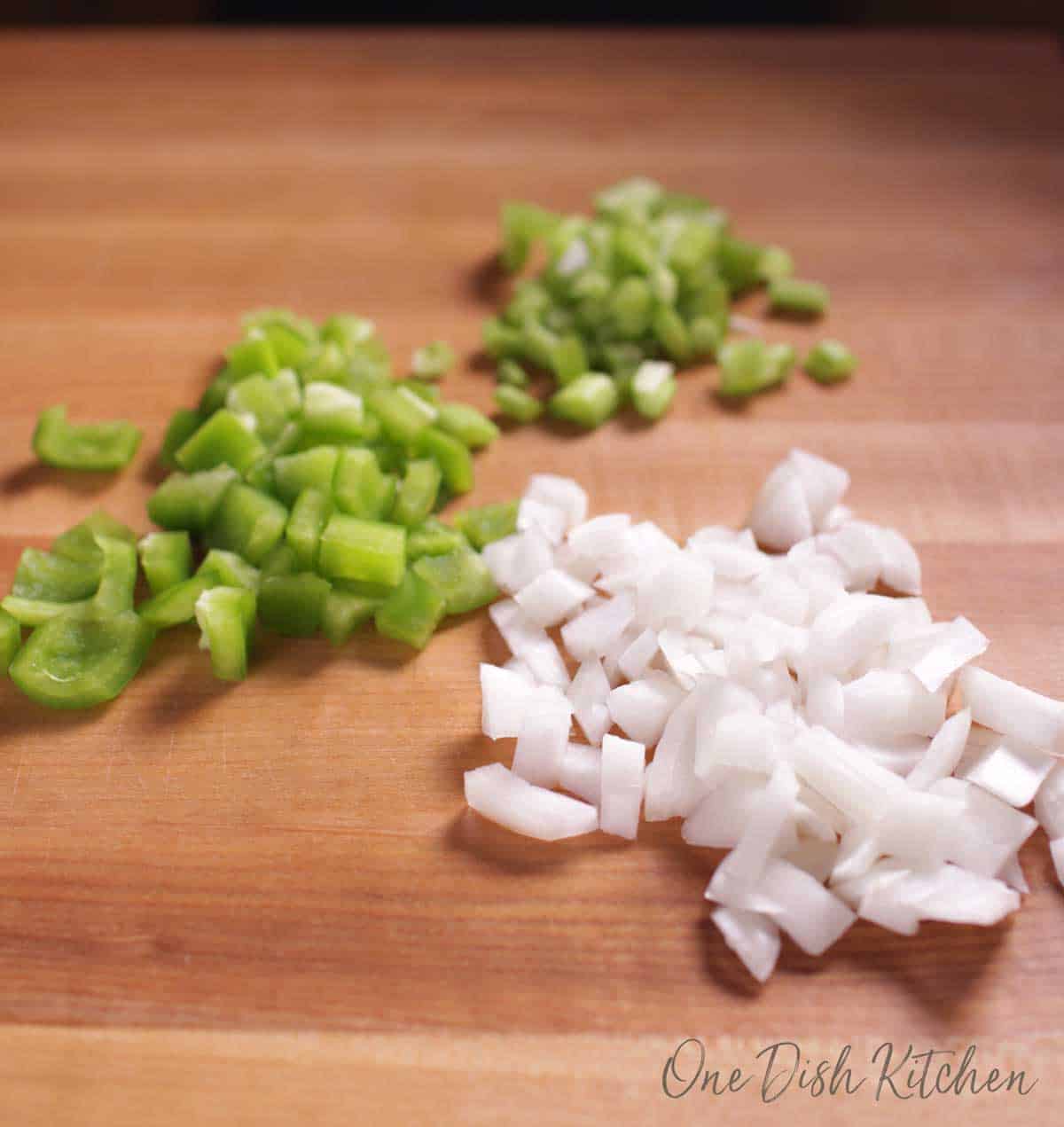
How To Shop For Shrimp: A Guide
When it comes to buying shrimp, particularly for single serving recipes, individually frozen, head-off, peel-on shrimp are often your best bet. These are readily available in the freezer aisle of most grocery stores and can be a cost-effective option when cooking for just one person.
Here’s the scoop: Many shrimp labeled as “fresh” in the supermarket’s seafood section are actually previously frozen shrimp that have been thawed. These are essentially the same shrimp you find in the frozen aisle, just defrosted. It’s challenging to determine how long these “fresh” shrimp have been thawed, which brings us to the issue of freshness.
Since shrimp are highly perishable, always give them a sniff test before purchasing. A strong ammonia smell is a red flag for spoilage. Additionally, look for physical signs of quality; avoid shrimp that appear limp, slimy, or disintegrated as these are indications of decay.
How To Peel And Devein Shrimp: A Simple Guide
The process of peeling and deveining shrimp is straightforward and can be done in just a few steps. If you’re looking for convenience, many stores offer shrimp that are already peeled and deveined. However, if you prefer to do it yourself, here’s a quick tutorial:
- Remove the Legs: Start by pulling off the tiny legs from the shrimp’s underside.
- Crack and Peel the Shell: Use your fingers to open the shell along the shrimp’s belly, then gently peel it away.
- Detach the Tail: Pinch the area where the shrimp’s body meets its tail and pull the tail off.
- Slit the Back: Carefully run a paring knife along the length of the shrimp’s back, creating a shallow cut.
- Devein: You’ll see the vein as a dark, gritty line along the shrimp’s back. Use the tip of your knife to lift and remove it.
Now your shrimp are prepped and ready for your favorite single serving recipes!
Mastering The Perfect Roux For Your Gumbo
The secret to an authentic Louisiana gumbo lies in its roux—a simple but essential mixture made with equal parts of oil and flour. Acting as both a thickener and a flavor base, the roux sets the stage for your gumbo’s complex and rich taste profile.
To craft your roux, you’ll combine equal amounts of oil and flour in a 2-quart pot. Stir this mixture continuously while cooking it over the stove for approximately 10 to 15 minutes. Your target is a caramel-like color, or the shade of a penny. Thanks to the smaller volume in this single serving recipe, reaching this hue will be quicker compared to making roux for a larger pot, which often takes between 20 and 25 minutes.
Keep in mind that your roux requires constant attention to avoid burning. Steady and frequent stirring is your best friend here. If the roux does end up burnt, you’ll have no choice but to discard it and start fresh, lest you risk ruining the entire dish with a burnt aftertaste.
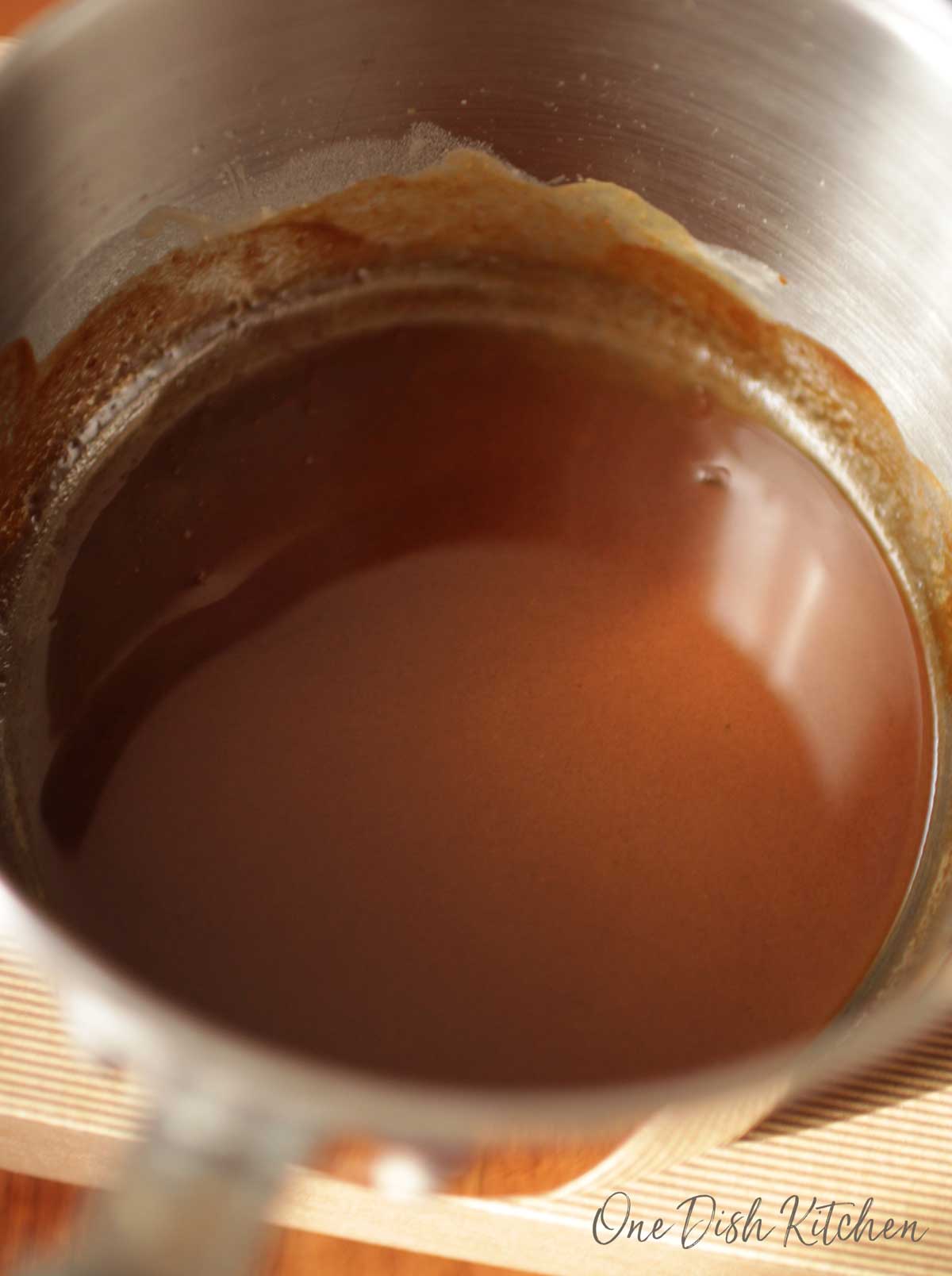
How To Make Seafood Gumbo For One
These step-by-step photos and instructions help you visualize how to make a small batch of gumbo. See the recipe below for ingredient amounts and full recipe instructions.
- Make the roux. Place a 2-quart pot over medium heat and add the oil. Allow the oil to heat for about 5 minutes, then add the flour to the pot. Stir the oil and flour together to form a roux. Continue to stir the roux for 10-15 minutes, or until the color of a penny or caramel.
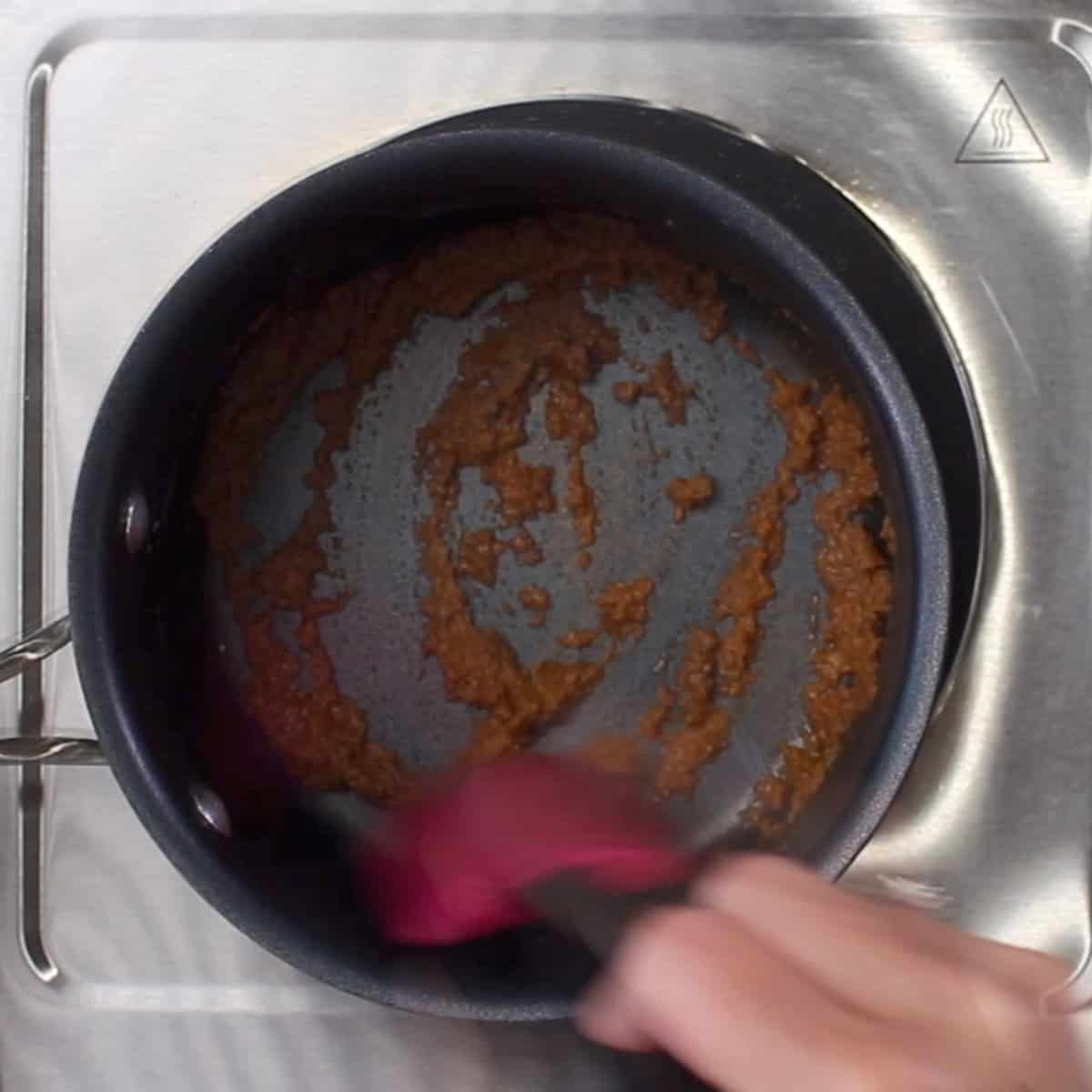
- Cook the vegetables. Add the onions, bell peppers, and celery to the roux and stir to blend. Stir the vegetables for 2 minutes, then add the garlic. Cook and stir the garlic for 30 seconds.
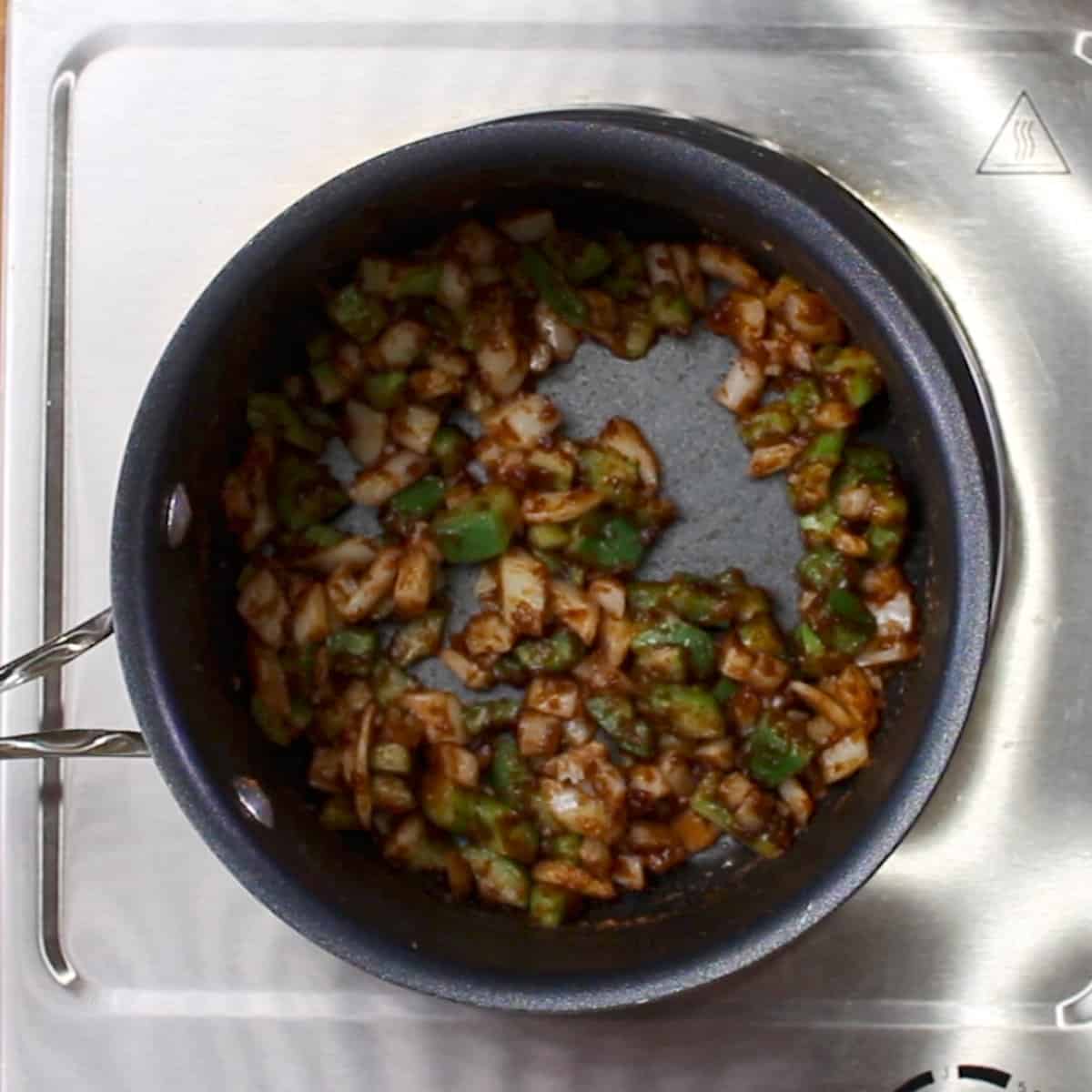
- Simmer the gumbo: Add the chicken broth to the pot. Season the gumbo with dried thyme, Worcestershire sauce, salt, and pepper. Bring the gumbo to a boil and lower the heat to low and simmer. Continue to simmer the gumbo for 40 minutes, stirring occasionally.
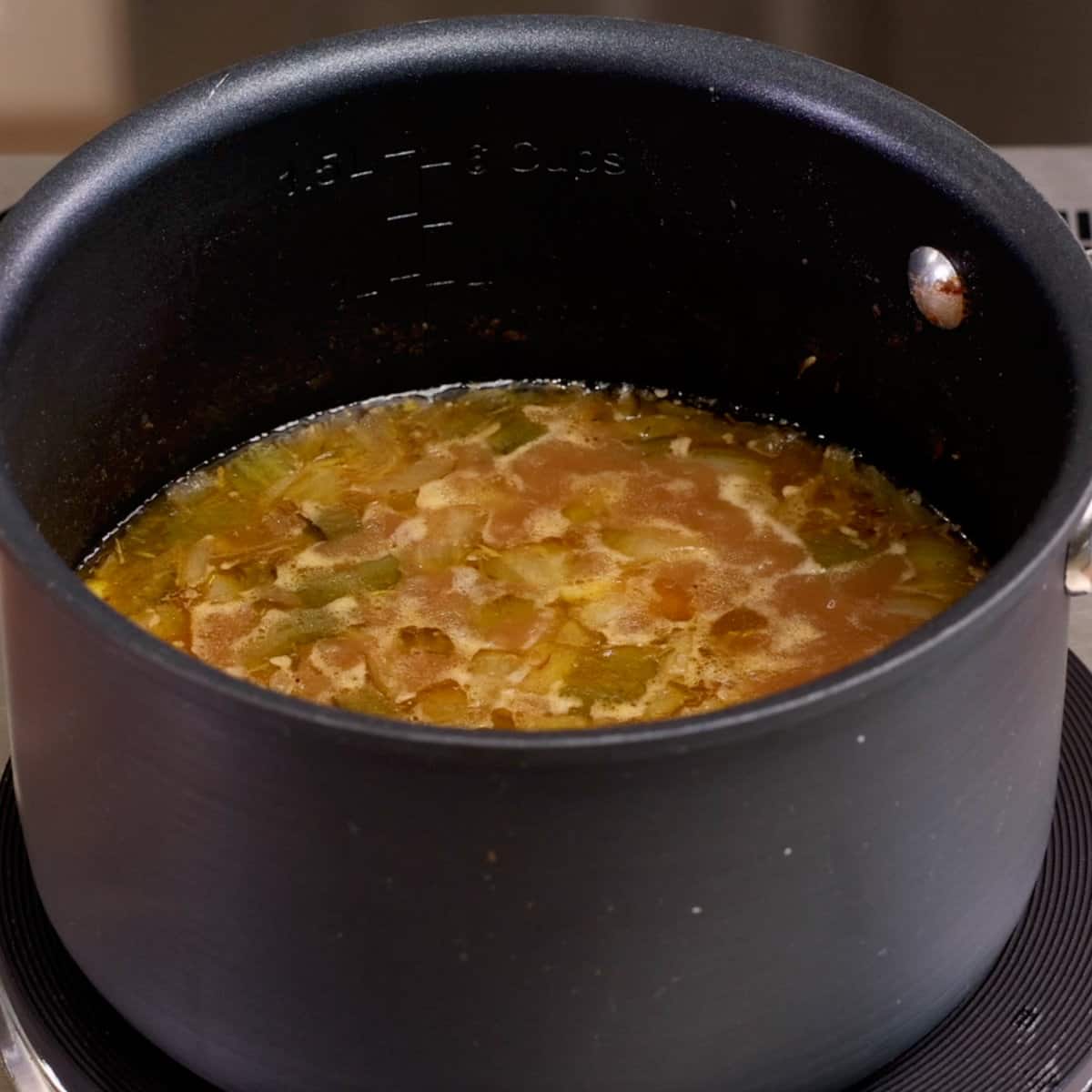
- Add the seafood: Season the shrimp and fish in a small bowl with ½ teaspoon of creole seasoning. Stir the shrimp and fish into the gumbo and cook for 5 minutes.
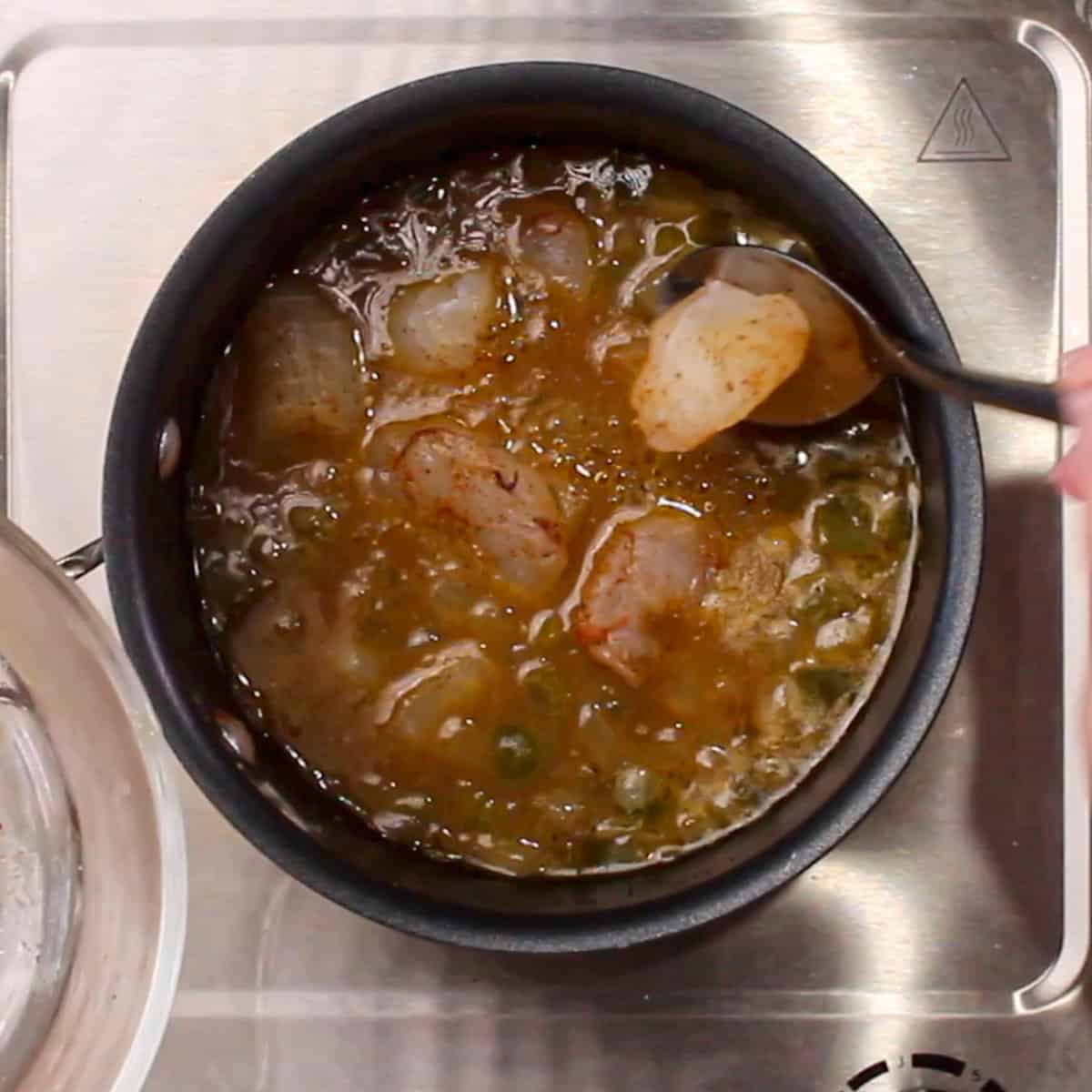
- Serve over cooked rice.
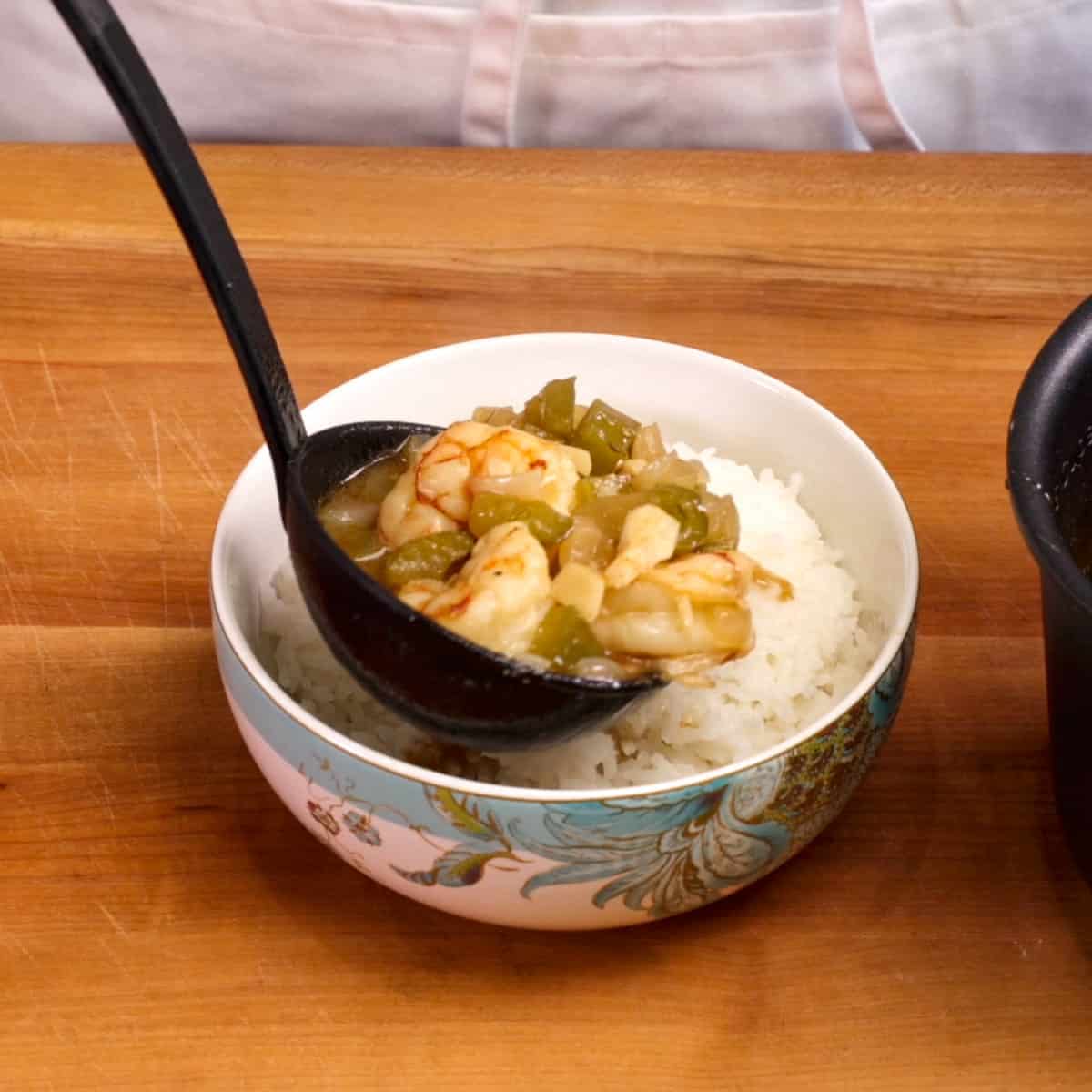
Expert Tips
- Before you start cooking, make sure to read the entire recipe, including the Ingredient Notes section, and examine the process photos. This detailed guide will help you understand how the recipe unfolds, ensuring your seafood gumbo turns out perfect every time. All the information you need is found within the body of this recipe post, so don’t miss a thing!
- Opt for White Fish: The ideal choice for seafood gumbo is a white fish such as catfish, snapper, grouper, or sole. If you’re feeling adventurous, you can even add crab legs and oysters alongside the shrimp to elevate your gumbo to the next level.
- Mind Your Roux: The roux is the cornerstone of any gumbo recipe. Pay close attention to its color as an indicator of its readiness; you’re aiming for a caramel or copper penny hue to achieve that authentic gumbo taste.
- Use the Right Tools: A heavy-bottomed pan or pot is crucial for even heat distribution, and a whisk is your best ally for consistent stirring, especially when making the roux.
- Patience is a Virtue: Gumbo isn’t a dish you can rush. Slow cooking is key for allowing the flavors to meld and enrich the overall dish. Your taste buds will thank you for the wait.
- Serve Over Rice: To stick to tradition, serve your gumbo over a bed of white rice. But don’t hesitate to mix it up once you’re comfortable with the basics.
- Customize Your Gumbo: Remember, no two gumbo recipes are exactly the same. Start with this foundational single-serving recipe and feel free to tweak the ingredients and seasonings to suit your personal preferences.
Serving Suggestions
Pair your gumbo with something that complements its rich flavors and textures. Here are a few side dishes to consider:
- Cornbread: A Southern classic that pairs beautifully with gumbo.
- White Rice: Serves as a simple base that allows the gumbo to shine.
- Pasta Salad: Lightens the meal and adds a crisp contrast.
- French Bread: Great for soaking up any leftover gumbo from your bowl.
Frequently Asked Questions
Gumbo and jambalaya may appear similar, but they have distinct differences. The primary difference is in how the rice is cooked. In gumbo, rice is cooked separately and served alongside, whereas in jambalaya, the rice is cooked with the other ingredients. Jambalaya is more akin to paella, featuring a blend of vegetables, broth, and spices, and varying based on the addition of different meats and spices.
For this easy-to-make gumbo recipe, a 2-quart saucepan is your best bet. To achieve optimal cooking results, make sure to use a pot of a similar size. For more information on the right kitchenware for single serving recipes, feel free to explore our FAQ page.
You can store your gumbo in an airtight container in the fridge for up to 3 days. To freeze, let the gumbo cool completely before transferring it to a freezer-safe container—separate from the rice. It will keep for up to 3 months. Thaw it overnight in the fridge and reheat on the stovetop or microwave.
Absolutely! If you’re looking to make more servings, simply double the ingredients listed in the recipe and use a larger pot for cooking.
Absolutely, flavors often improve with a little resting time.
Ways To Use Leftover Ingredients
If you have any ingredients leftover from this recipe, check out our Leftover Ingredients Recipe Finder or you might like to consider using them in any of these single serving and small batch recipes:
If you’ve tried this seafood gumbo recipe or any recipe on One Dish Kitchen please let me know how you liked it by rating the recipe and telling me about it in the comment section below.
Also, if you take a picture please tag us on Instagram (@onedishkitchen) we’d love to see it!
Seafood Gumbo For One
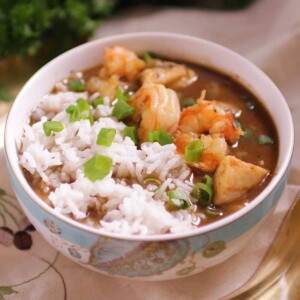
Watch How To Make This
Equipment
Ingredients
- 2 tablespoons canola oil or vegetable oil
- 2 tablespoons all purpose flour
- ½ cup chopped onions
- ¼ cup chopped green bell peppers
- ¼ cup chopped celery (about 1 stalk)
- 1 clove garlic , minced
- 2 cups low sodium chicken broth or low sodium shrimp stock
- ¼ teaspoon dried thyme
- ¼ teaspoon kosher salt
- ¼ teaspoon coarsely ground black pepper
- ¼ teaspoon Worcestershire sauce
- ½ cup peeled and deveined shrimp
- 4 ounces white fish cut into 1-inch pieces (catfish, grouper, snapper, sole)
- ½ teaspoon Creole seasoning (I use Tony Chachere's)
Instructions
- Place a 2-quart pot over medium heat and add the oil. Allow the oil to heat for about 5 minutes, then add the flour to the pot. Stir the oil and flour together to form a roux. Continue to stir the roux for 10-15 minutes, or until the color of a penny or caramel.
- Add the onions, bell peppers, and celery to the roux and stir to blend. Stir the vegetables for 2 minutes, then add the garlic. Cook and stir the garlic for 30 seconds.
- Add the chicken broth to the pot. Season the gumbo with the thyme, Worcestershire sauce, salt and pepper. Bring the gumbo to a boil and lower heat to low and simmer. Continue to simmer the gumbo for 40 minutes, stirring occasionally.
- Season the shrimp and fish in a small bowl with 1/2 teaspoon of creole seasoning. Stir the shrimp and fish into the gumbo and cook for 5 minutes.
- Taste the gumbo and add additional salt if necessary. Serve over cooked rice.
Notes
- Before you start cooking, make sure to read the entire recipe, including the Ingredient Notes section, and examine the process photos. This detailed guide will help you understand how the recipe unfolds, ensuring your seafood gumbo turns out perfect every time. All the information you need is found within the body of this recipe post, so don’t miss a thing!
- Opt for White Fish: The ideal choice for seafood gumbo is a white fish such as catfish, snapper, grouper, or sole. If you’re feeling adventurous, you can even add crab legs and oysters alongside the shrimp to elevate your gumbo to the next level.
- Mind Your Roux: The roux is the cornerstone of any gumbo recipe. Pay close attention to its color as an indicator of its readiness; you’re aiming for a caramel or copper penny hue to achieve that authentic gumbo taste.
- Use the Right Tools: A heavy-bottomed pan or pot is crucial for even heat distribution, and a whisk is your best ally for consistent stirring, especially when making the roux.
- Patience is a Virtue: Gumbo isn’t a dish you can rush. Slow cooking is key for allowing the flavors to meld and enrich the overall dish. Your taste buds will thank you for the wait.
- Serve Over Rice: To stick to tradition, serve your gumbo over a bed of white rice. But don’t hesitate to mix it up once you’re comfortable with the basics.
- Customize Your Gumbo: Remember, no two gumbo recipes are exactly the same. Start with this foundational single-serving recipe and feel free to tweak the ingredients and seasonings to suit your personal preferences.
Nutrition
The information shown is an estimate provided by an online nutrition calculator. It should not be considered a substitute for a professional nutritionist’s advice.
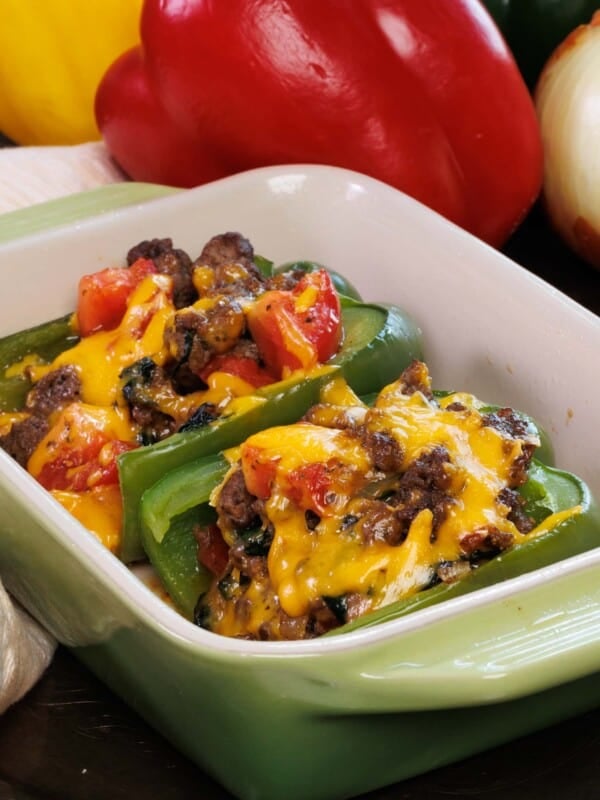
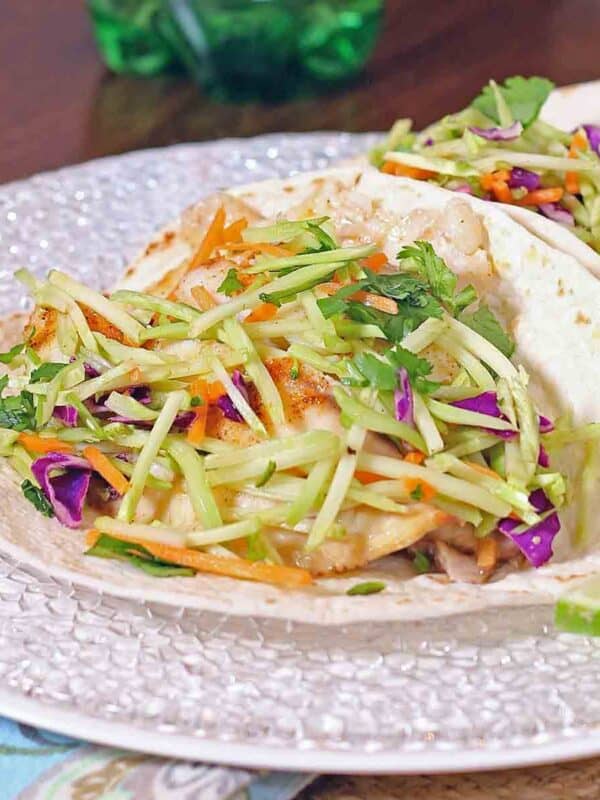
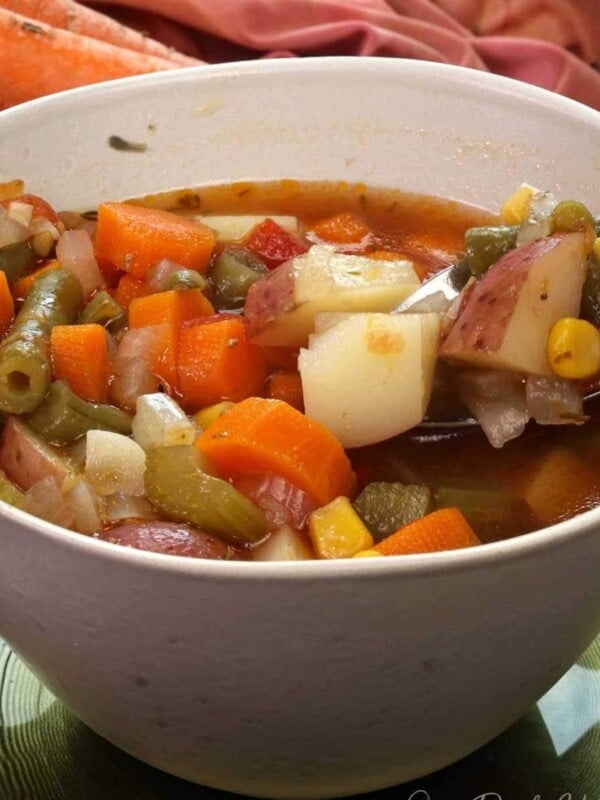
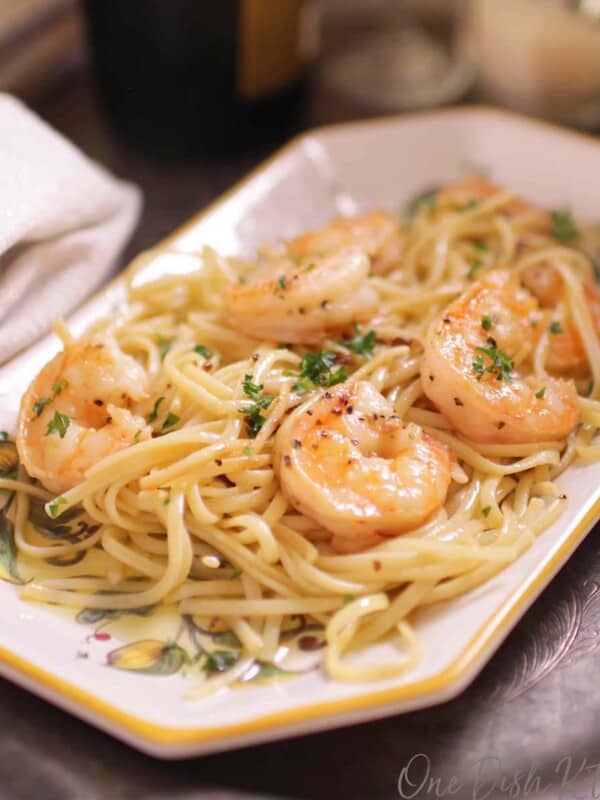
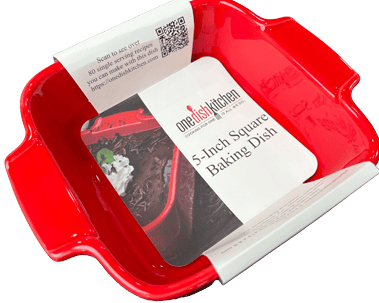










Hi! Beer is in the ingredients photo but not in the instructions
Hi there! Thanks for pointing that out. Yes, you’re right—beer is shown in the ingredient photo. When I make a big batch of gumbo, I like to add beer for extra depth of flavor. For this single serving recipe, the amount of beer I would have used was minimal, so I chose to leave it out since it didn’t make a noticeable difference in the flavor. I apologize for not updating the photo to reflect this and we have left beer off the ingredient list. However, enjoying your gumbo with a cold beer on the side is always a great idea! Cheers!
I followed the directions exactly and this gumbo was awesome. I took the recipe to the store with me because l am not familiar with shopping for, nor cooking with seafood. Bought Red Snapper, and raw peeled, deveined shrimp. I will make this gumbo from now on. Trying Jambalaya next! Thank you Joanie 👍🏾
I’m so happy you enjoyed it!
Love your recipes. Simple, using good ingredients, great instructions, awesome dishes for one alone or easy to double.
Thank you for this website. Merry Christmas and Happy New Year!
Thank you so much! I’m so happy to know you are enjoying our recipes.
I have been making a few of your recipes for about one year now. This is one of my favorite seafood dishes. I didn’t add the fish, instead I added more shrimp and followed the recipe as written. VERY GOOD.